
The start point for the best source of fleet information |
Final report: Vauxhall Corsa long-term test
Date: 27 April 2021 | Author: Tony Rock
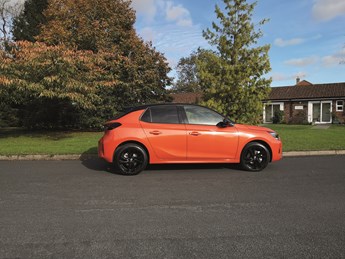
|
|
||||||||||||
Final Report: Vauxhall takes its Corsa
We've had to say goodbye to the Vauxhall Corsa that's been in my possession for the past six months. Due to the coronavirus restrictions, it's not covered the miles it might have done in pre-pandemic times - no M25 trips to the office, no weekends away to stay with relatives, no long treks taking children to distant sporting competitions - but it has made it off the driveway often enough during lockdown, particularly when searching for new countryside walks, for me to know that I'll miss this 'sporty number'.
That's Vauxhall's description for the Corsa in SRi trim, which is how ours came equipped. It's one rung up the specification ladder from SE, which means the interior gets extras such as alloy-effect sports pedals, a Sport mode button, 'sports-style' front seats and tinted rear windows. There's also a sporty-looking flat-bottomed leather steering wheel, although it is standard throughout the range.
Several driver assistance features are also available at no extra cost on the Corsa. They include lane-keep assist, cruise control with intelligent speed-limiter, forward collision alert, a driver drowsiness system, and speed sign recognition.
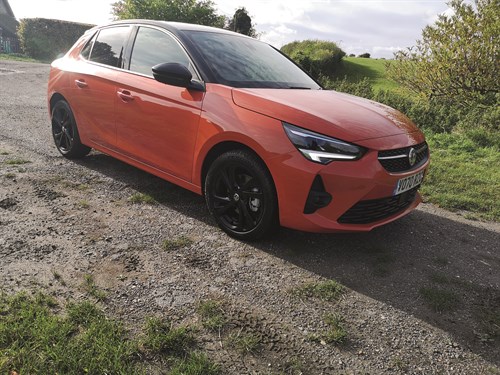
In terms of practicality, the 309-litre boot did the job for regular 'top-up' grocery store visits, but when the kitchen shelves were really bare, the footwells in the back and the rear seats themselves were needed for the 'click and collect' trips to the Tesco car park (which was one way of avoiding the potential health risk associated with going inside the store). There are enough storage bins and hollows around the front of the cabin. They include a glovebox, door bins, small slots in the doors, plus three mouldings between the seats - two for drinks and one possibly to rest a mobile phone at an angle. There's also a larger space - beneath the 12V power supply, USB slot and air con controls - where we kept the essential hand sanitiser.
When we weren't transporting foodstuff on the back seats and were instead exploring alternative walking routes nearby, my three kids - including two teenagers - considered the passenger space in the back to be on the cramped side.
Being a largely lockdown review gave me the opportunity to play with a couple of the mobile apps that are available for the owners of Vauxhall vehicles. Android Auto was one, which gives access to the likes of Google Maps for people like me who generally prefer it to manufacturer-installed satellite navigation systems. My Vauxall was the other. It enables you to monitor mileage and fuel consumption, break individual journeys down into categories, such as personal and business, and locate the Corsa if you've forgotten where you've left it. You can use it, too, to book appointments with a dealer.
However, when I wanted a dealer, I resorted to the old-fashioned idea of using my mobile phone to make a call. The Corsa required a replacement windscreen when the original suffered a stone chip and the freezing temperatures opened up a long crack. After National Windscreens had carried out the work, a dealer was needed to recalibrate the advanced driver assistance systems (ADAS) tech on the new glass. Enter Perrys in Aylesbury, who got the job done while I sat and waited in their socially distanced showroom.
Unfortunately, an electrical glitch that appeared very soon after the Corsa's arrival, and then disappeared for most of its half-year stay, surfaced again in the car's final days with us, a few weeks after that visit to the dealer: the vehicle sometimes wouldn't respond to the door-opening button on the key fob being pressed, and would only open after the boot lid was lifted and closed again. Which was irritating, although not enough to alter our overall view that the Corsa had been a more than competent performer.
5th Report: Split-screen view
It might not feel like it now, but it wasn't that long ago we were in the midst of a spell of freezing cold weather that seemed to go on forever. Temperatures not that far from where I live got down to a bone-shivering -7 degrees C. Icicles hung around for days and days.
The below-zero temperatures took their toll on the Corsa's windscreen. A crack appeared overnight, which I only noticed when I was about to take a trip, after leaving the heating and wipers on to clear the ice beforehand. A closer inspection suggested that water had turned to ice in a stone chip in the far corner of the windscreen on the driver's side, and opened up the fault line.
Our Corsa was covered by National Windscreens, who sent a mobile technician out to fit the replacement on my drive a few days later, and the work was done without fuss in under an hour. After the job was completed, the technician said the crack probably had appeared overnight, which was why I hadn't spotted it when I first went to the car on the morning the damage appeared - according to him, warming the windscreen to clear the frost was what had caused the crack to grow.
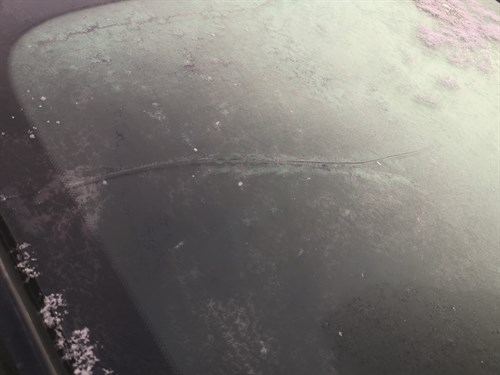
He also said he was unable to complete the job fully because National Windscreens didn't have the software to recalibrate the advanced driver assistance systems (ADAS) tech on the new glass. For that job, I had to book in with my closest Vauxhall dealer, which was Perrys. That meant booking an appointment for what they said was an unusual job and taking the car into Aylesbury several days later.
The visit didn't go as smoothly as my dealings with National Windscreen, due to a combination of disruption caused by Covid-19 and technology difficulties.
Firstly, my phone's satnav took me to the van dealership rather than the car one. Fortunately, an employee there opened a ground-floor window (the front door was locked due to the site being only partially operational because of Covid-19) and directed me to the right place. I then parked outside the Vauxhall part of the dealership site - which was also closed due to Covid-19 - and was directed on foot to the Peugeot doors, where I was told by a reception member of staff that I was "late".
Once I was booked in and handed the keys over, I eventually settled down, at a socially distanced desk with hand sanitiser, to log on to the Business Car servers - and couldn't initially because the Wi-Fi log-in details pinned to the side of the coffee machine were out of date.
A Perrys' employee thanked me for letting him know, told me he would inform IT and suggested I use my phone as a Wi-Fi hotspot. That worked, and meant I was able to continue working until the Corsa keys were handed back to me two to three hours later with the recalibration complete.
4th Report: Keep on the right track
The first time the steering wheel turned by itself while I was driving the Corsa was a little disconcerting, to say the least.
I was on a local, countryside A-road, where the speed limit maxes out at 50mph on certain stretches, and was arcing around a bend when the steering wheel twitched back in the opposite direction.
My initial reaction was to (be alarmed and) grab the steering wheel tighter. In doing so I noted a symbol flashing yellow in the instrument panel. It was an image of car flanked by converging dotted lines, which is the symbol of the lane-keep assist technology that comes as standard on the Corsa.
So there was no need to feel any trepidation because the car was behaving as it should: warning me, with the aid of camera technology, that I'd strayed too close to the white lines and correcting my position to keep the Corsa in its lane.
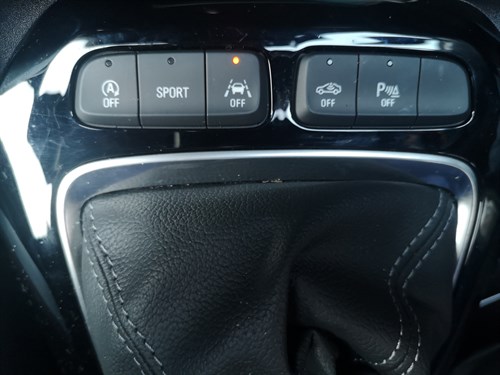
It works at speeds over 40mph and doesn't intervene when you've used the indicators to warn of a change of lane.
There's an argument to be had, however, about whether it's necessary for the types of shortish, countryside journeys I've been doing ever since the third lockdown commenced.
The insurers Direct Line recently published an online magazine article describing the technology as a potential "guardian angel" for regular motorway users who might be in danger of nodding off at the wheel, due to the soporific nature of travelling mile after mile at 70mph.
But it also said that drivers on narrow, country roads might become irritated by the car constantly tut-tutting when there's a legitimate reason to nudge the centre white line. I have to say I've found it to be more of a hindrance than help during lockdown - fortunately, if you feel the same, the system can be turned off by simply pressing a button found behind the gear stick. I've done that, although, if I ever get out on faster, straighter roads with the Corsa again, I'll be sure to turn it back on.
Lane-keep assist is one of several driver assistance features available as standard on the Corsa. Other technologies include cruise control with intelligent speed-limiter, forward collision alert (which operates automatically from 3mph and gives an audible warning, as well as a visual warning when approaching another vehicle too quickly), a driver drowsiness system (it monitors driving time and driving behaviour to help prevent accidents caused by tiredness), and speed sign recognition.
3rd Report: App chat
Another day, another lockdown. With driving limited to the occasional 'click and collect' or supermarket food shop visit, meaning fewer opportunities to sit behind the wheel of the Corsa, I decided to play with a couple of the apps that are available for the owners of Vauxhall vehicles.
I've written previously that I'm a practised late-adopter of technology - everything from a mobile phone to social media, to adaptive cruise control has been embraced with the speed of
a man unable (and maybe unwilling) to see anything wrong with landlines, email, and my ability to keep a safe distance behind the car in front. Not that I'm frightened of new developments - it's simply that it takes a while for me to appreciate why they should be adopted.
It's the same with mobile phone car assistant apps, like Apple Carplay or Android Auto, which allow drivers to interact with selected functions on their mobile devices via the vehicle's infotainment screen. If a car like the Corsa can already give me directions (built-in satnav), allow phone calls (via Bluetooth), and play music (FM and DAB radio), why would I want to access the very similar functions on my phone?
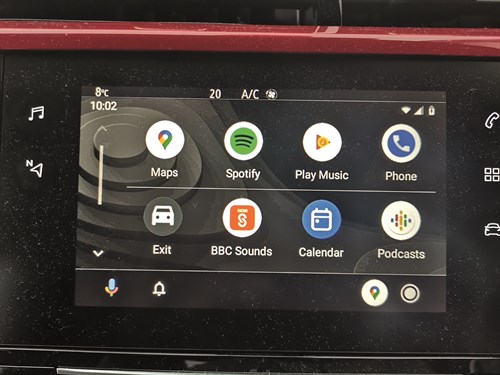
My Huawei mobile comes with Android Auto installed. The phone's USB cable has to be connected to the Corsa for it to work. The engine must be off too when you first pair the phone and car via the Android Auto button on the touchscreen. In a bid to keep warm, I tried repeatedly with the engine running while parked on the driveway, and received several 'check your connection and try again' alerts on the Huawei's screen. A bit of time spent educating myself on how to set up Android Auto beforehand would have avoided both the above issues.
Once it's all set up, you'll have access to the likes of Google Maps and Waze. Despite suggesting I would have no use for a duplicate guidance system, I actually prefer Google Maps to most of the options offered by manufacturers. Some, too, will prefer having Google Maps projected on the Corsa's touchscreen to sticking an in-car phone holder on the windscreen or dash and viewing the mobile phone screen. One downside to Android Auto compared with the built-in Vauxhall satnav, however, is that you sacrifice having directions shown on the information display behind the steering wheel.
Android Auto also provides access to any podcasts you've downloaded, or apps such as Spotify. I have the BBC Sounds app on my phone, and spent some of my time on the driveway browsing its offering of shows.
The second app I tried had to be downloaded and that was My Vauxall. Once you've signed up and inputted data, such as your car's VIN and mileage, it connects to your Vauxhall via Bluetooth. It enables you to monitor mileage and fuel consumption, break individual journeys down into categories, such as personal and business, and locate the Corsa if you've forgotten where you've left it. You can use it, too, to book appointments with a dealer and it lets you know of any forthcoming maintenance work. Cleverly, you can set it up so that your chosen dealer will contact you automatically should the car alert you of any problems. I also, via the app, signed up for the Live Navigation service, which is free for three years and finds the best route in real time using the car's satnav system, based on up-to-date traffic information.
If my experience of tech adoption is anything to go by, I suspect that with both apps you won't realise you need them until they become a regular part of your life.
2nd Report: Are you sitting comfortably?
Vauxhall describes the SRi trim of the Corsa as a "sporty number". Being one level up from the ground floor that is SE, that means the interior gets a few showy-off touches like alloy-effect sports pedals; a Sport mode button, which is found in front of the gear stick and alters how the steering wheel and accelerator pedal responds, making the car drive in a sporty fashion; and "sports-style" front seats, as opposed to the "comfort" seating offered in the trim below.
Finding a comfortable sitting position won't be a problem for most drivers, as the seat is adjustable for height, can be reclined, and slides backwards and forwards. However, there's no lumbar support, something this occasional sufferer of lower back discomfort would find beneficial. Also, the passenger seat can't be adjusted for height at this trim level - for that extra flexibility you have to specify at least the next trim up, which is Elite Nav. Of course, costs have to be cut somewhere on lower trim levels to justify the step up to the next one, something Vauxhall is not alone in doing in this sector of the market, but not having the same adjustment for both front seats seems unnecessarily mean to me.
I don't feel at all cramped in the front, but I do tend to drive with the seat pushed quite a long way back, which is unfortunate for anyone sat behind me as that really impacts their space - so much so that even my eight-year-old has pointed out how little room she has on the morning school run. However, that particular problem is easily solved, if only I could remember to shift her seat over to the left before the race to the school gates starts. Despite my daughter's opinions, there is room for her and her two siblings to squeeze in the back, or space for two adults to sit comfortably - if I compromise my own legroom.
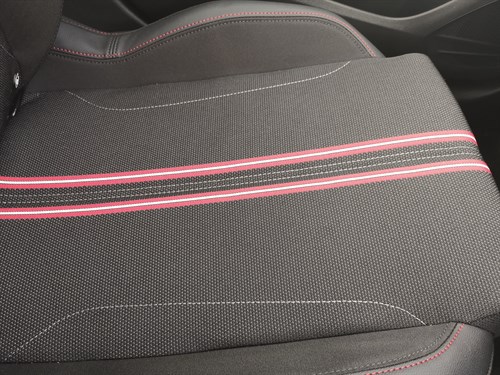
Like the rest of the interior, the seat fabric is largely dark, bar the, for example, red and white stripes and the "Signal Red and Dark Titanium" stitching. That red ties in with a segment of the dashboard that is rather fancily described as a "Liquid Palladium facia with Hot Red accents''. For those wondering what that means, my dictionary tells me that palladium is a rare silvery-white metal resembling platinum and has the chemical element of atomic number 46. In non-scientific terms, the dash is partly silvery grey.
Which brings us to the Corsa cabin in general. We've written before, in a first drive, that the quality "is decent, albeit with a lot of the hard-plastic surfaces that are still found in many small cars", and that "some of the interior fabric designs help inject a little more character". So as well as the streak of horizontal red running along the dash, there are chrome-effect touches dotted around, such as the door handles, while the prevailing black comes in various textures: as perforated speakers, as high gloss around the screens, as cloth roof-lining, in the patterned effect on the top of the dash. Some say that this attempt to make the cabin appear more upmarket is superficial - but in my opinion so is Sydney, and that's still a fun place to hang out.
There are enough storage bins and hollows around the front. They include a glovebox, door bins, small slots in the doors, plus, three mouldings between the seats - two for drinks and one possibly to rest a mobile phone at an angle. There's also a larger space - beneath the 12V power supply, USB slot and aircon controls - where our family currently keeps the hand sanitiser.
Finally, returning to the sporty theme, the SRi model features tinted rear windows and a sporty-looking flat-bottomed leather steering wheel, although the latter is actually standard throughout the range.
1st Report: Corsa comes on board
The Corsa, Vauxhall's biggest-selling car, has joined the Business Car fleet. The latest model went on sale at the end of 2019, and having been subject to one of our First Drive reports at the start of the year it's now time for an extended run.
As the Vauxhall Grandland X/Peugeot 3008 and Crossland X/2008 were signed off before the PSA acquisition of Vauxhall/Opel was completed, it's actually the first all-new model to come out since the takeover. It has also been built on the same platform as the new Peugeot 208, and as such is a close relative (the forthcoming new Vauxhall Mokka/Peugeot 2008 are on the same platform too, as well as the Citroën C4 lower-medium hatchback that's due soon).
We've got the SRi Nav Premium model. The 'SRi' part of that name is the trim, and there are four of those, the others being SE (followed by our sporty SRi), Elite Nav and Ultimate Nav (the latter two, to me at least, sounding like the names you might give to a first-person shooter Xbox games with a military theme). Within the SRi spec, there are four packs available: SRi, SRi Nav, SRi Premium and, at the top, our model, SRi Nav Premium. A similar arrangement is repeated for the SE-spec cars. The more luxurious Elite Nav also comes with an Elite Nav Premium pack, while the Ultimate Nav trim sits alone at the top of the specification pile.
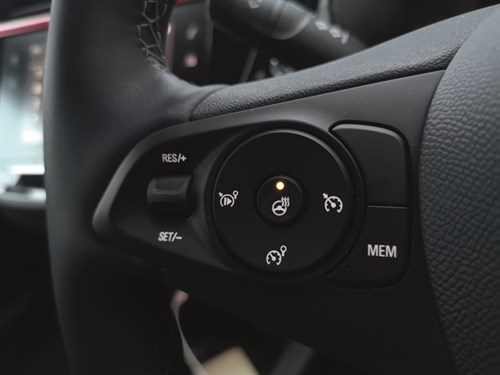
Standard kit on all models across the range includes cruise control with speed-limiter, automatic emergency braking, forward collision alert, lane departure warning, speed-sign recognition, driver drowsiness alert, DAB radio, Bluetooth, and Apple CarPlay and Android Auto, while our particular model adds, for example, rain-sensitive windscreen wipers, rear parking sensors, heated front seats and steering wheel (both of which are nice at this time of year), satellite navigation, and a 7in colour touchscreen.
Our long-termer is fitted with a turbocharged 100hp 1.2-litre petrol engine, with WLTP emissions of 125-134g/km, depending on specification, and fuel economy quoted at a range of 47.9-52.3mpg. The figures for ours are 126g/km and 50.4mpg. However, there is also a 75hp 1.2 petrol. There is, too, a 102hp 1.5 diesel, plus an electric Corsa, called the Corsa-e.
Our test model comes with the six-speed manual gearbox rather than the optional eight-speed automatic transmission, while that six-speeder is also a partner for the diesel engine. The lower-powered petrol gets a five-speed manual gearbox.
On the outside, the Power Orange two-coat premium paintwork is a £650 option.
Worryingly, we were affected by a couple of electrical glitches very soon after the Corsa's arrival. First up, the vehicle would occasionally fail to respond to the door-opening command from its own key fob, and would only unlock after the boot was lifted and closed again (a fault that I think occurred after not shutting the boot fully on one occasion). Secondly, after clumsily folding in the door mirrors by accident when adjusting the angle via the control, it would take a little while before they could be tilted again once back in their normal position. Thankfully, both glitches seem to have resolved themselves, and the Corsa is functioning as it should - particularly those heated seats and the heated steering wheel, which have just started to come into their own.










